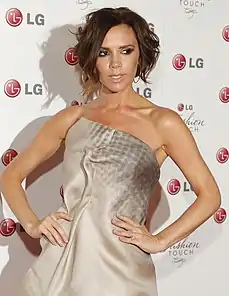Size zero
Size zero or size 0 is a women's clothing size in the US catalog sizes system. Size 0 and 00 were invented due to the changing of clothing sizes over time (referred to as vanity sizing or size inflation), which has caused the adoption of lower numbers. For example, a 2011 size 0 is equivalent to a 2001 size 2, and is larger than a 1970 size 6 or 1958 size 8.[1][2] Modern size 0 clothing, depending on brand and style, fits measurements of chest-stomach-hips from 30-22-32 inches (76-56-81 cm) to 36-28-36 inches (90-71½-90 cm). Size 00 can be anywhere from 0.5 to 2 inches (1 to 5 cm) smaller than size 0.[3][4] Size zero often refers to extremely thin individuals (especially women and adolescent girls), or trends associated with them.
Criticism

The use of size 0 in advertisements and products of the clothing industry has been met with some media attention. In July 2009, Katie Green won a competition to represent Wonderbra. They referred her to the Premier Model Management agency for representation. Green reported that "one of the guys from the PR agency from Wonderbra" insisted that she lose weight, that it wasn't normal for models to be a (UK) size 8. "Unless I could drop down to that weight, they wouldn't be willing to get me more work."[5] Green at first complied, but then quit the agency. She then, with Liberal Democrat MP Lembit Öpik, launched a campaign titled "Say No to Size Zero". They began a petition drive with the goal to put an end to size zero and underweight models on the catwalk or working in the fashion industry. They set a goal to obtain 20,000 signatures and plan to present it to the UK Prime Minister and Parliament. They are campaigning for legislation that would require regular health checkups for all models before undertaking any assignments.[6]
Movement against size zero

After the death of Luisel Ramos from anorexia in August, 2006, Madrid Fashion Week banned size zero models the following month, and the Milan fashion show took the same action shortly afterward, banning models with a body mass index (BMI) of 18 or below. As a result, five models were banned from taking part.[7]
As of 2007, the British Fashion Council promoted the creation of a task force to establish guidelines for the fashion industry. They also urged fashion designers to use healthy models. In September 2019, Victoria Beckham received criticism on social media over thin models who appeared "ill" in her Fall fashion show. In 2015 she had "vowed that her agents were in touch with the agents of all the models she uses in an effort to make sure that the women are healthy". Representatives for Beckham did not respond to Fox News’s request for comment.[8]
Italian fashion labels Prada, Versace and Armani have agreed to ban size zero models from their catwalks.[9] Under the new self-regulation code drawn up in Italy by the government and designers, all models in future shows will be "full-bodied", and larger sizes will be introduced at shows.[10] Fashion designer Giorgio Armani has given support to the effort to eliminate ultra-thin models. "The time has now come for clarity. We all need to work together against anorexia."
Israel banned underweight models in March 2012. Their law stipulates that women and men hired as models must be certified by a physician as having a body mass index (BMI) of no less than 18.5.[11] The legislation also requires the inclusion of an informational note in adverts using photos manipulated to make models look thinner.[12] There were divergent views on the ban within the Israeli fashion industry. One modelling agent, who had helped promote the bill, suggested that the fall in typical dress sizes for models in the preceding 15–20 years amounted to "the difference between death and life". However, another described the law as "arbitrary" and "not appropriate for every model".[13]
References
- "Body Measurements for the Sizing of Women's Patterns and Apparel" (PDF). 1958. Archived from the original (PDF) on 2016-03-04. Retrieved 2017-08-01.
- "Body Measurements for the Sizing of Women's Patterns and Apparel" (PDF). 1970. Archived from the original (PDF) on 2016-03-07. Retrieved 2017-08-01.
- "Aeropostale Size Chart". Retrieved 16 September 2012.
- "American Apparel Women Shirts Size Chart". Retrieved 16 September 2012.
- "They said I was too fat, says Wonderbra sensation Katie Green" (Flash video). News of the World. Retrieved 19 May 2011.
- Snape, Katie (9 August 2009). "Today's Sunday Live". skynews.com. Archived from the original on 12 August 2009. Retrieved 10 August 2009.
- "Skeletons on the Runway: The "Size-Zero Debate" | Britannica Blog". Britannica.com. Archived from the original on March 4, 2012. Retrieved 2013-03-14.CS1 maint: unfit URL (link)
- McCarthy, Tyler (3 Sep 2019). "Victoria Beckham criticized for using 'ill-looking' model to promote latest clothing line". Fox News. Retrieved 24 January 2020.
- Metro
- CBS News
- Turner, Sally (Mar 20, 2012). "Israel Passes Law to Ban Underweight Models". Retrieved March 20, 2010.
- "Israel bans use of ultra-skinny models". Reuters. 20 March 2012.
- "Israel passes law banning use of underweight models". BBC News. 20 March 2012.